Project 1: Enigma
- Due before 23:59 on Wednesday, September 14
- Submit using the submit program
as
301 proj 1.
Our first project doesn't involve any data structures, it's just good OOP practice. This is the hardest programming you've done. Please get started early.
1 History
Substitution ciphers that encode a message by substituting one character for another go back at least as far as Julius Caesar, who used a rotating character scheme to encode military orders. As we know from SI110, this simple type of encryption is extremely vulnerable to statistical attacks, however. In World War II, the German military employed an encryption scheme that addressed this weakness of simple substitution ciphers. This scheme, implemented by typewriter-sized devices known as Enigma machines, was believed by the Germans to be unbreakable.
2 Simple Model of the Enigma
Enigma machines used interchangeable rotors that could be placed in different orientations to obtain different substitution patterns. More significantly, the rotors rotated after each character was encoded, changing the substitution pattern and making the code very difficult to break. For examples, let's pretend there are only six letters in the alphabet, and we have the three rotors below.
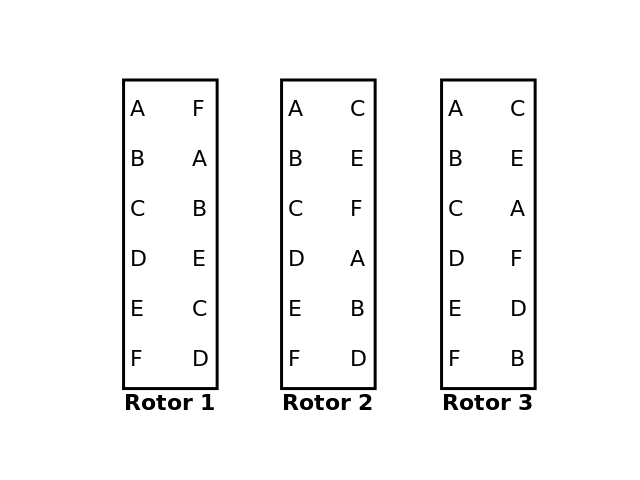
In the first rotor, if an 'E' is entered, a 'C' comes out. If an 'A' comes in, an 'F' comes out. Whatever comes out of the first rotor, goes into the second rotor. Whatever comes out of the second rotor, goes into the third rotor. For our simple model, whatever comes out of the third rotor is the encrypted character. For example, to encrypt a 'D'...
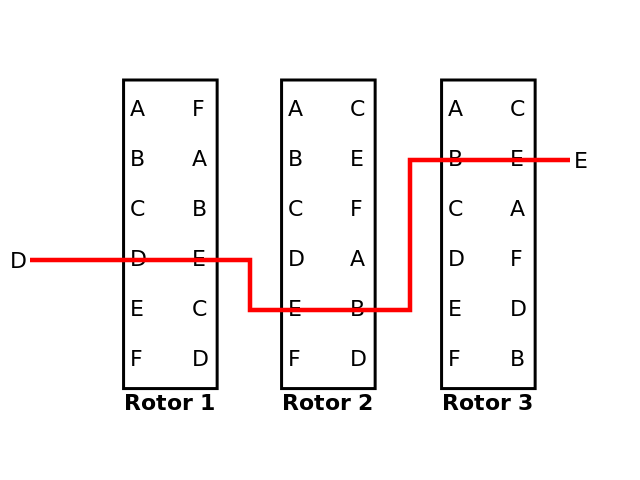
At this point, it may seem that this is just a substitution cypher, just an unnecessarily complex one. Well, after encrypting this 'D', Rotor 3 is rotated one slot (in the below picture, notice how in the third rotor, 'A' no longer maps to 'C' - instead, it now maps to 'E', which is the letter 'B' used to map to. In other words, each letter in the right column has moved up one spot). So, when we encrypt 'D' again, we get a different encrypted character.
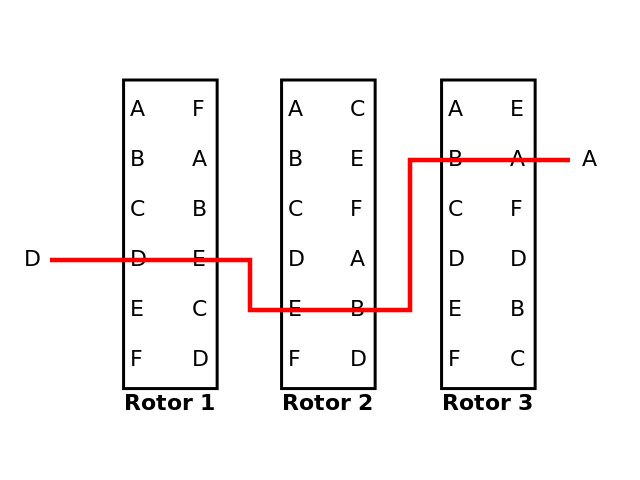
OK, fine, you say, so it's not a substitution cypher. But, because the rotor must eventually rotate all the way around again, it is just a Vigenere cypher with a key length of 6, and those are still vulnerable to a statistical attack. So here's the second twist... when that third rotor is rotating around to return to its original position (after the encryption of the 6th character), the second rotor rotates once as well, again changing the encryption. When the second rotor rotates all the way around, the first rotor clicks once, as well. So, the rotors don't return to their original position until you have typed 6^3 characters (26^3 if we're using a full alphabet). Essentially, this message has the same statistical properties as a one-time pad.
But how would this be decrypted? Well, each day the Germans had a secret key, consisting of how to put the rotors in the machine. If you had them in the machine in the proper places, you merely had to run the encryption backwards, allowing the rotors to click after each letter as if encrypting, and you would get the message back out.
3 The Assignment
Part One: 75/100 points
In this part, you will build an Enigma machine capable of encrypting and decrypting messages. You'll have to build two classes, Rotor and Enigma.
Rotor
A Rotor will have a list of characters as a field, which encodes the order
of the letters in the rotor. The first character in the list will be whatever
character is at the top of the Rotor (for example, in the first rotor in the
images above, the list would be ['F','A','B','E','C','D']. In
addition, a Rotor will have a constructor, and three other methods.
The constructor should take a single String as an argument which contains
the encoding of the Rotor. For example, to build the first rotor above, you
would call inner=Rotor("FABECD") (for real messages, these strings
will consist of 26 characters, not just the first six). The constructor
should take the characters of the String, and put them into the list.
The method encryptLetter(self, letter) should return that rotor's
encoding of the character letter. So, for the first Rotor in the
image, r.encryptLetter('D') should return 'E'.
The method decryptLetter(self, letter) should do the opposite.
So, in the first Rotor, r.decryptLetter('E') would return
'D'.
The method click(self) should turn the rotor one click. After
calling click on the first rotor, the first character should be 'A'. If this
click completes one entire time around (meaning the new first element was the
first element when the rotor was first initialized), it should return True.
Otherwise, it should return False. You may find it helpful to add another
field to your class to make this work more easily.
Enigma
Your Enigma class should have as fields three Rotors. I'm not going to give as much guidance on what an Enigma should be able to do, but at the very least, it should have methods called "encrypt" and "decrypt" that accept a String as an argument, and return another String.
Additionally, the Enigma should have a constructor, which accepts as
arguments three strings describing the three rotors' initial settings (ie, for
the above example, e=Enigma('FABECD','CEFABD','CEAFDB')).
For testing, first test just your decrypt function by decoding the following messages using the following settings:
- First rotor:
SHBMFWEIQRODTAVXCPYZUJKGNL - Second rotor:
GYRFNUCZLQDWMKHSJOEPBVITXA - Third rotor:
MSEWGQHDPRFNXATOIBUJLCZVYK
OQMTANMGPABQSDAKAUFXXGJBSPHBZXHLXMBNOHTNQZQGDBMIQNZJ
MXNMFKPDVWDPIMPYACVYZUGUWGPVGAOXCDZDGYTLATOIBUJLCZVYNXATOIBUJLCZVYKMSEWGQHDPRFIBUJLCZVYKMSEWGQHDPRFNXATOWGQHDPRFNXATOIBUJLCZVYKMSEZVYKMSEWGQHDPRFNXATOIBUJLCXATOIBUJLCZVYKMSEWGQHDPRFNFNXATOIBUJLCZVYKMSEWGQHDPRDPRFNXATOIBUJLCZVYKMSEWGQHUJLCZVYKMSEWGQHDPRFNXATOIBRFNXATOIBUJLCZVYKMSEWGQHDPTOIBUJLCZVYKMSEWGQHDPRFNXAGQHDPRFNXATOIBUJLCZVYKMSEWOIBUJLCZVYKMSEWGQHDPRFNXATSEWGQHDPRFNXATOIBUJLCZVYKMCZVYKMSEWGQHDPRFNXATOIBUJLPRFNXATOIBUJLCZVYKMSEWGQHDJLCZVYKMSEWGQHDPRFNXATOIBUVYKMSEWGQHDPRFNXATOIBUJLCZMSEWGQHDPRFNXATOIBUJLCZVYKHDPRFNXATOIBUJLCZVYKMSEWGQYKMSEWGQHDPRFNXATOIBUJLCZVBUJLCZVYKMSEWGQHDPRFNXATOIQHDPRFNXATOIBUJLCZVYKMSEWGATOIBUJLCZVYKMSEWGQHDPRFNXLCZVYKMSEWGQHDPRFNXATOIBUJZ
You can then test your encrypt by encrypting, and then decrypting, and making sure you end up with the same thing you started with. I'll be testing your code with my own examples, so be sure to be thorough.
Advice: As you work on a larger programming assignment, don't try to tackle everything at once. Instead, keep on thinking about solving a simpler problem. For example, before worrying about rotor rotations, first write a program which will correctly encrypt and decrypt a single character.
Please put all of your classes in a file called enigma.py.
4 Part Two: 100/100 points
The reason why the Enigma cryptosystem was considered secure by the Germans is not because it was impossible to break, but because the system was so complex, that by the time a message was broken, it wouldn't matter any more (modern cryptosystems actually work the same way, we've just made things even more complex). After all, to find the correct rotor settings for that day, somebody would have to try every possible combination of rotor settings, perform the decryption, and see if the output looked like German. With three rotors in any order, and 26 possible settings for each rotor, the number of possible messages is \(26^3 \cdot 3!\), which equals 105,456 possible decryptions to check - impossible by hand, a challenge for 1940s computing, and very fast with any modern computer like your laptop! (I'll note that our Enigma thus far is a simplified version; the true number of possible keys was 10,586,916,764,424,000.)
Researchers at Bletchley Park, England (led by Alan Turing), heavily used the work of Polish mathematicians, and built machines known as bombe (from the Polish "bomba kryptologiczna," or "cryptologic bomb") to eliminate many of these initial settings as impossibilities, and then run the remainder through a machine (arguably a computer) allowing for timely decryption of Nazi messages. This is hailed as one of the turning points of the war, and the first great success of computer science.
In order for this to work, they needed to know what part of the message was, so they could figure out which Enigma settings could produce that message. They eased their effort with non-computational approaches. For example, once the English learned that Enigma operators had been told to spell out their numbers, Turing discovered 90% of all messages contained the word "ONE." Therefore, a message containing the string "eins" was much more likely to be the correct decryption. Additionally, if it was particularly important to find that day's rotor settings, they would lay mines in sight of German lookouts, knowing they could anticipate a message containing the word "mine." This made it much easier to scan all the candidate plaintext messages for the word "mine" in order to find the correct one. Still another approach was that some operators liked to have a personal "sign-off" phrase; a message sent by that operator could be assumed to have that sign-off phrase included.
For the second part of this project, using your own Enigma machine that
you made for part 1, you are going to build a Bombe. Below is some long
cryptotext; your job is to decrypt this cryptotext WITHOUT knowing the rotor
settings. Know that aircraft just MINEd the coast, and that odds are, the
message contains the word ONE. The rotors are the same as in part one,
though they obviously haven't started in the same settings, and may not be in
the same order.
To do this, you'll have to try every single possible setting for the
three rotors given in part 1, in every possible order, and see which ones
might make sense. Make a seperate file called bombe.py
that contains a class called Bombe. Your Bombe class can have
whatever else you want in it, but it must have a constructor that
takes three arguemnts for the rotor strings (though they might be in the wrong order),
and it must also have a method crack(self, ciphertext) that tries
all possible Enigma settings using the given rotors, and returns a list of possible
decryptions that contain both the word "MINE" and the word "ONE".
For your own testing, here is a message for you to try that should have exactly one possible decryption, using the same rotor settings as in the previous part:
NPWCDPBRIVDZGARYLECHBTOCKJCMJVDRFZEYFWJTRZLPDEVDHIJXYHRBRJTVVQCFDQUWHRQKYPYFAJJKSDEJVOVZNWYFYINBPBSNHZAGDACJRYRLLJAWCJKHTEVATAAZWVUHSBTCKBVHTNSGFDPHGIZDSZXMBSIKWLMMISUQNWCRPSHSNFAALBQNMKESIHCPGVRTRFTPRYTRIRMNYMVSLEKAPRISAUSTRXQFVCLYWXZLLXHHKHJJUTPKHBTFENHMFRLFLUHYQJSCMNEBB
5 Part 3: Plugboard/Reflector (110/100)
Put part 3 in a separate file called enigmaFull.py. Submit
both enigma.py and enigmaFull.py (and bombe.py) if you do this part.
There was more to the Enigma than just the rotors, though they were the main innovation. There was also a plugboard, with six wires, which performed a simple pairwise substitution on 12 of the letters first.
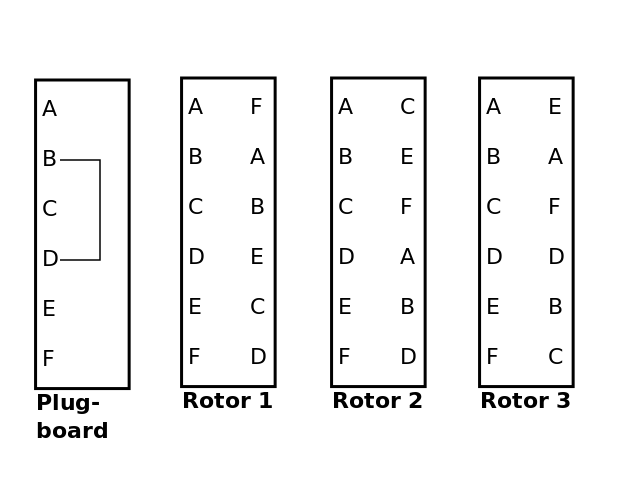
In the above picture, we've added a plugboard, in which if 'B' is entered, it is substituted with 'D', before being sent on to the first rotor. Similarly, if 'D' is entered, it will be replaced with 'B'. If 'A' is entered, it leaves the plugboard as 'A', because no wire has been placed in its plug. The below picture illustrates how to encrypt a 'D' with these settings.
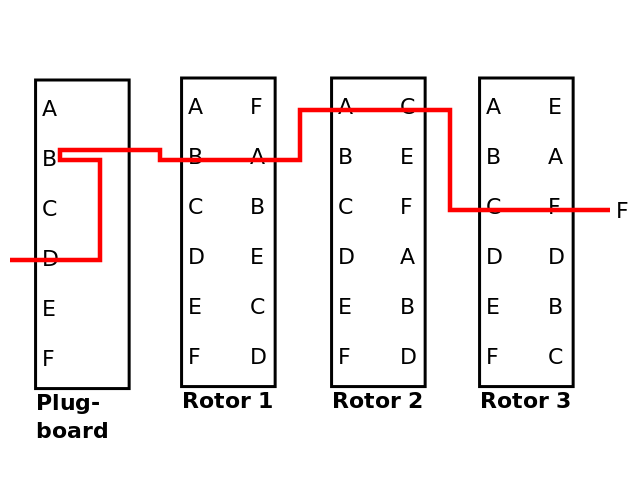
This plugboard massively increased the number of possible settings for the Enigma, making Alan Turing's job much, much more difficult.
Finally, there was a reflector. The reflector was similar to the plugboard, in that letters were combined pairwise, but differed in that every letter has a partner. Additionally, once the reflector output a letter, that letter was fed back through the rotors and plugboard in reverse.

And here's a picture of a full Enigma encryption:
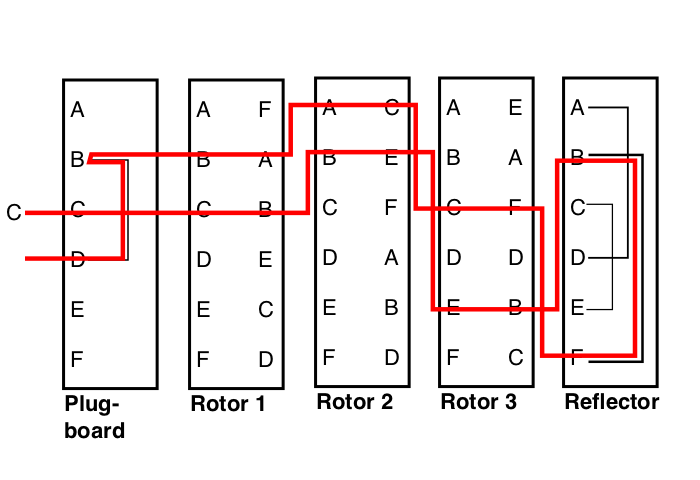
Here, the D is entered, the plugboard converts it to a B, which goes through the rotors and comes out as an F. At this point, it enters the reflector, where it comes out as a B, due to the fact that F is paired with B in the reflector. This letter then moves backwards through the rotors, emerging from the rotors as a C. Because C is not paired with anything on the plugboard, the C enters and leaves the plugboard without being altered. So, the D is encrypted as a C. And then the third rotor would rotate.
For the extra credit, implement the full Enigma machine. The
reflector is static and never changed, so you can hardcode in the following
pairings: EW, OG, DM, BC, TI, VJ, PA, LH, YQ, UR, XF, NS, ZK.
The plugboard pairings will have to be entered as initial settings to the Enigma, though, as an additional (first) argument to the constructor, like:
e=Enigma(['AB','CD','EF','GH','IJ','KL'], rotorset1, rotorset2, rotorset3)
This list of two-character strings tells you which letters are paired with what other letters.
Other than this modification to your contructor, the methods in your Enigma class should have the same names and number of arguments as before. Of course, they will work differently! And you can add other classes, methods, fields, as needed to get this working. Be sure to write useful comments to document your design!
Here is a message encrypted using the same rotors as in part 1,
plus the 6 plugs AB CD EF GH IJ KL and the hard-coded reflector.
PMXGAXBPKCGDMYQSJKLHCXFLAXTQMUSOCYFULTYJCCGIOPKGOPRVMRKY
Do not make a bombe for this. It won't finish. There is a little over 100 billion ways to arrange six wires in the plugboard, so take the amount of time your bombe took in part 2, and multiply by 100 billion. That's a long time. You don't want to wait for that.
6 More information
Our Enigma machine is a vast simplification of what was a brilliant machine special-built to defeat every pre-existing approach for breaking cryptosystems. If you understand how the Enigma worked, and WHY it was constructed the way it was, you will understand all of cryptographic theory up through World War II (which is when mathematics takes over). It's also a fascinating study of the role of pure research in warfare.
The below video does a great job of discussing these topics. From 0:00-28:49 is a discussion of the traditional attacks that had been used to crack "secure" messages, including German messages in World War I. 28:49 on is about how the Enigma worked, how it defeated those techniques, and the new vulnerabilities that it introduced that the Poles and British were able to exploit. This is not required viewing because it has nothing to do with Data Structures, but it's pretty relevant for your major and careers!
Also, did you know there's a movie about Alan Turing starring Benedict Cumberbatch and Keira Knightly?